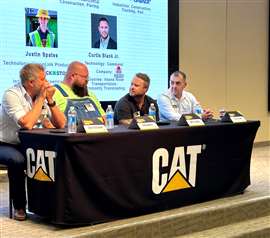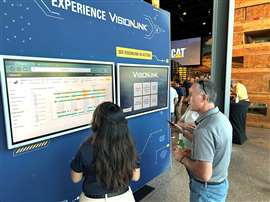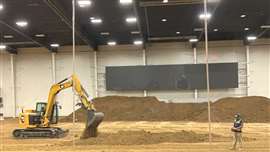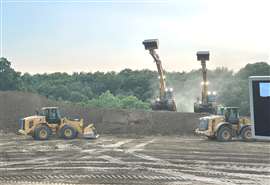Key takeaways from Caterpillar’s Construction and Technology Days
23 July 2024
Modern technology’s rapid evolution in the last decade has been equal parts spectacular and overwhelming; ask any mid-sized or small construction contractor how they perceive it and it may just answer the latter.
 Members of the Caterpillar’s Construction and Technology Days panel on emerging technologies. Pictured from left are Shay Stutsman, James Bennett, Bryce Wuori, and Tyler Flynn. (Image: Mitchell Keller)
Members of the Caterpillar’s Construction and Technology Days panel on emerging technologies. Pictured from left are Shay Stutsman, James Bennett, Bryce Wuori, and Tyler Flynn. (Image: Mitchell Keller)
Now, more than ever, the once ‘emerging’ high-tech features of construction machines appear to be becoming the norm.
With such advances, it’s as important of a time as ever to ask: Is my company keeping up or falling behind?
Discussing the matter at Caterpillar’s Construction and Technology Days at the company’s facility in Edwards, Illinois, US, was a panel of seven US contractors who explained to a room of end-users and business owners exactly how to level up their firm with the right tech.
The panel consisted of: James Bennett of Otto Baum; Robert Gaines Blackwell of Partners Excavating; Curtis Blank Jr. of Associated Terminals; Tyler Flynn of Savage; Shay Stutsman of Stutsman Gerbaz; Bryce Wuori of Pavewise; and Justin Spates of Luck Stone.
New tech as labour aids, not ‘Big Brother’
Frequently throughout the discussion, the seven panellists encouraged owners and managers to have an active role in implementing new technology for their crews and fleets and highlighted the importance of using modern data and work-tracking software as an ally, not a meddlesome monitoring system.
Perhaps the technology seen as most invasive by operators and crew members is machine and worksite monitoring software.
“It’s not a ‘Big Brother’ tool,” iterated Justin Spates, whose firm Luck Stone produces crushed stone and aggregates. He added anyone implementing monitoring software for the purpose of checking up on their employees is likely to get severe pushback from the crew.
“[Implementation of technology] really falls flat on its face when you do it that way,” he said.
Instead, Spates encouraged incorporating the crew in understanding how data is analysed and used. He said doing so can increase productivity, particularly as operators become more aware of what positive and negative actions lead to data notifications.
 At the Caterpillar Construction and Technology Days welcome dinner, a Cat Visionlink expert discusses the program with a visiting guest. (Image: Mitchell Keller)
At the Caterpillar Construction and Technology Days welcome dinner, a Cat Visionlink expert discusses the program with a visiting guest. (Image: Mitchell Keller)
As an example, one operator may have an excessive idle time on a Monday. Using that information, managers can work with the operator to see why the machine idled for longer than expected and use proactive solutions to limit idle time on Tuesday.
“We use it as a training opportunity, as a development opportunity,” explained Spates.
Bryce Wuori of Pavewise also encouraged contractors to stay away from becoming their employees’ ‘Big Brother’ – another of at least a half dozen mentions of the Orwellian idea when discussing data software. He said, using the toolset to encourage positive use of machines and worksite time leads to better results.
“We found a crew, and they had success on it,” said Wuori, who said managers could then commend the workers, while showing them what exactly they did right.
What they did ‘right’ could be anything from reducing idle time, operating the machine in a way that reduced average fuel consumption, or limiting machine-destructive movements.
By the next shift, a different crew – catching word of the data-based results – wanted to perform better than the prior team.
“We were maxing out incentives on density on projects [and] being super-efficient to the point where we could even take a roller off the mat because we were being so efficient with the others,” he said of the performance of the workers after introducing healthy, data-based competition. “Each crew wants to be the A-team, right?”
The same with in-cab and on-site cameras; the panel found that operators, initially, were opposed to the idea until they realised the immense safety benefits they provide. Cameras that can identify exterior surroundings, as well as determine if an operator is distracted, were widely accepted, the panellists said, once the purpose was amply explained.
“Cameras tend to have a kind of negative thought process,” acknowledged Wuori. “But we’ve seen resistance of our team members to now full acceptance. We have drivers and operators that will not operate the piece of equipment unless their cameras are working.”
Remote operations should be carefully implemented
 A Caterpillar operator, on right, runs an excavator, on left, remotely at the OEM’s Edwards, Illinois, US, demonstration and training facility. (Image: Mitchell Keller)
A Caterpillar operator, on right, runs an excavator, on left, remotely at the OEM’s Edwards, Illinois, US, demonstration and training facility. (Image: Mitchell Keller)
A major shift in the last decade regarding machine operations is the ability to remote-control machines.
It’s a future gamechanger for the construction industry, but one that comes with a high price-point to start and mild uncertainty.
For Curtis Blank of Associated Terminals – a stevedore and terminal operator located in Louisiana, US – the unique nature of their business (unloading cargo from barges on the Mississippi River) using Cat Command (a remote operations platform) was a common-sense approach.
“Our goal is to remove personnel from harm’s way,” said Blank, who noted remote operations means workers can oversee heavy lifts away from the barge and cranes.
In part due to their unique work, skilled labour is often in short supply, which Blank said worsened during the pandemic.
“The ability to be dynamic with labour, to touch different sites without having to send personnel to those sites, which could be 150 miles apart, became very valuable and it just began to scale from there,” he said.
But what was common sense for Associated Terminals isn’t necessarily for every firm. Even Blank noted that he’s eager for remote capabilities to start implementing 3D plans, which would increase operator control and limit accidents and damage compared to the current 2D scheme-building software.
“We set safe zones, benchmarks,” he said. “We’ve got a steel floor, a lot of structure in the area we can damage on the ship. The 2D side of things helps us at least set some thresholds.”
Now, Blank is already eagerly waiting a new update to the existing tech. “Once 3D comes in, it’ll be a game changer for us, again,” he said.
Contractors retaining and finding new employees with modern tech
That technology in construction can be a bridge to encourage a new workforce to enter the industry has been said so often it might feel like a platitude.
But the panellists all noted how embracing modern construction technologies has brought about a noticeable difference among their existing workforce and their future one.
Shay Stutsman of Stusman Gerbaz Earthmoving, regarding grade control technology, said, “Now that we’ve implemented all this, our retention of employees has been absolutely tremendous.
“In fact, we now are getting more applications than we ever have because people want to come and run this equipment.”
Grade control for dozers and excavators has existed for decades, but today’s programmes are even easier to use and more accurate than before. Where an operator once needed hyper-
 A night demonstration at Caterpillar’s “Tech Days” showcased the company’s various technology initiatives in-action in real-time. (Image: Mitchell Keller)
A night demonstration at Caterpillar’s “Tech Days” showcased the company’s various technology initiatives in-action in real-time. (Image: Mitchell Keller)
focused physical control of a machine to cut the appropriate grade, the worker can now simply input the needed information into a machine and let it do the work.
Stutsman noted this reduces time, cost, and operator fatigue.
“They want to be part of this process. They have these new toys, they’ve got this technology, [and] it’s been absolutely amazing to see how our operators have grasped the technology and see how many people have wanted to come to work for us because of it,” he said.
Altogether, Stutsman estimated his return on investment in modern grade control machines came after one year.
“If you can see a return on investment in less than a year, I kind of think that’s a no-brainer, right?” he said. “It’s not what something costs. It’s what it saves you.”
Blank responded, on his end, that he’s also seeing access to new workforce demographics as his company invests in construction technology.
“You obviously want to open up your labour pool to the widest possible. In south Louisiana… traditionally it’s been a male operator workforce for us,” he acknowledged. “What we’ve seen is we’ve been able to tap other labour markets. Now we have females that want to run equipment for us.”
Remote operation technology, Blank said, also opened the door to workers with physical limits.
“We’ve had employees in the past that have disabilities, and we’re able to bring these folks in,” he added.
Technology can be scary (and expensive), but worth the investment
Ultimately, not every tech solution works for every construction company, but there are definitely modern tools that can benefit even the smallest of firms.
Instead of delaying the inevitable, contractors and builders would be wise to make investments in the right tech now or risk falling behind the competition.
Blank summed up the sentiment of the day, commenting that, “It’s about being competitive in the market. What we’ve really learned over the years [adopting new tech] is you’re miles ahead of your competitor. Early adoption of some of these things… it has so much upward potential.”





